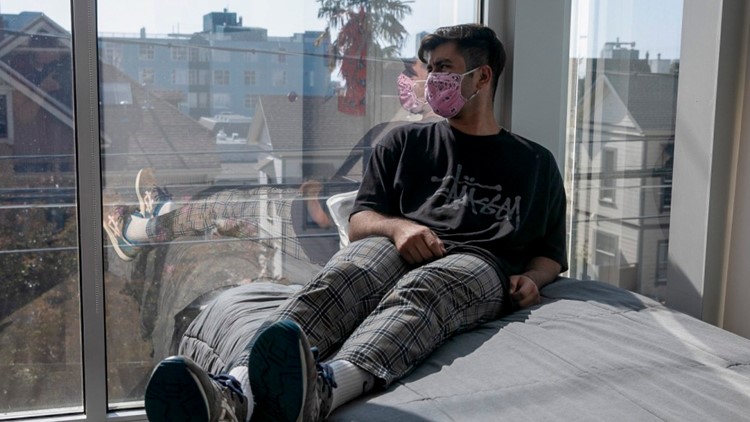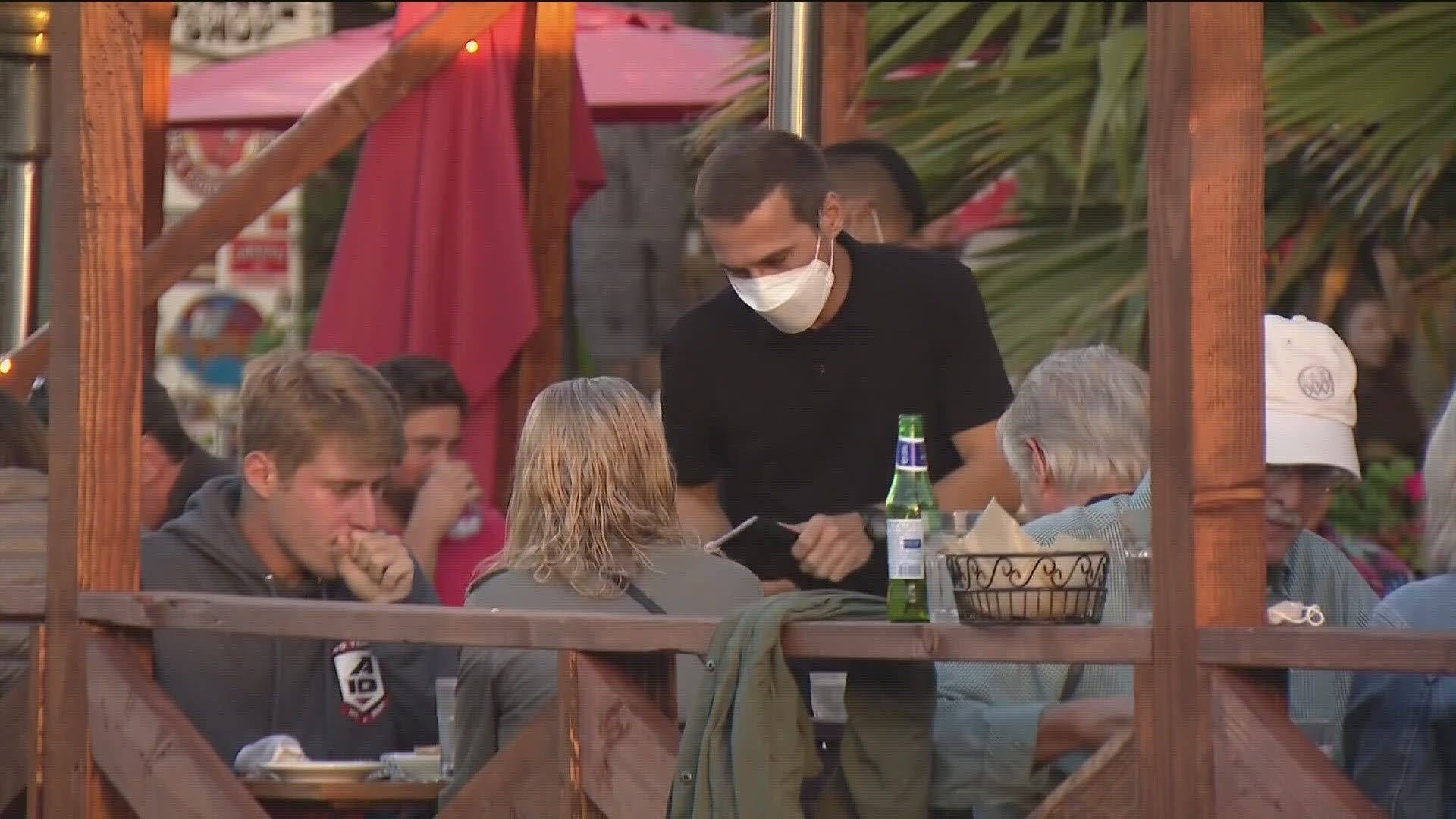SAN DIEGO — Early this summer, Carly Schaffer was flying to her hometown of San Marcos from The George Washington University in the nation’s capital. Not too long after arriving home, she felt incredibly ill.
Shortly after, she tested positive for COVID-19.
Schaffer said she was sick for two months. During this time, she reported having serious respiratory issues.
“It was unlike anything I’ve ever experienced,” Schaffer said. “I was 19 years old and literally felt like I could not breathe.”
Schaffer ended up returning to the DC area after feeling better, living in a cohort of roommates taking their remote classes.
But this holiday season, Schaffer will not be coming back to San Marcos. She said her mom is at a higher risk of developing serious symptoms should she contract the virus. Schaffer said she will not be taking any more chances.
“This is real, this is a real problem,” Schaffer said. “Be thankful you have the access to that technology so you can have that family zoom call.”
Schaffer is one of the thousands of students facing the same dilemma of coming home for the holidays. Colleges themselves are dealing with how, and why, they should send students home.
This is significantly enhanced in California, where as of November 16, 41 counties were deep inside the purple tier, California’s most restrictive bracket for reopening businesses amid the pandemic. An unfortunate sight, seeing how only nine counties were in the purple two weeks prior.
The Centers for Disease Control and Prevention recently issued travel holiday guidance for college students. The organization’s recommendations said students should not be treated as part of a family’s household when they return to their hometowns.
It recommends outdoor dining, with prominent mask usage, even for children returning home from college. The safest way for households to celebrate Thanksgiving with their children living at universities is to do so virtually, according to the CDC.
However, local universities here in San Diego are offering options for students who are choosing to return home for Thanksgiving.
On top of the holiday season, colleges like San Diego State and UC San Diego have also scrambled to shift their handful of on-campus operations to an online format for the rest of fall instruction. A move universities have had to do in the past, and are now heading into what health leaders are forecasting to be a ‘dark winter’.
SDSU shifts online amid rising county cases, plans for the holiday season
SDSU had a rocky start in handling the pandemic with multiple outbreaks reported in the surrounding area and a massive spike in cases stemming from student parties.
The school soon squelched the egregious case rate by implementing security patrols in the College Area and establishing mandatory testing for its on-campus community. The case rate was stabilized throughout the month of October.
Now, with hospitalizations in the county at record highs and daily case counts pushing up to 1,000 per day, SDSU is slowly reporting increasing rates of the virus as well.
Between November 19 and 20, the university added 63 new cases of the virus to its COVID-19 dashboard. 37 of these cases were reported at a previous date by the county and were found to be related to SDSU due to contact tracing.
26 of the remaining cases were newly reported cases connected to SDSU. This is a big increase that mirrors pre-mandatory testing periods at the university.
“The off-campus cases are in line with the increase in cases seen across the county and the state,” said in an SDSU statement sent over an email. The university also added the case count is updated twice every week, different than previously reported at the start of the semester.
Only a handful of classes were in-person at SDSU this semester. They were mainly labs and other hands-on courses. These must all transition into a virtual format by Thanksgiving, according to a recent email from the university.
Gabriella Kalbach is a graduate student at SDSU in the ecology program. She said that while the move to remain online hurts both students and teachers, it was the right decision.
“Of course for students, it’s not ideal and I know everybody is struggling with online (learning),“ Kalbach said. “But it’s far better than being in person and all of us getting sick.”
2,200 students living in residential housing were required to have informed the university of their post-Thanksgiving plans. SDSU said in the statement that only 600 of these students will be staying home.
In its layout for post-Thanksgiving plans, SDSU emailed students on November 2 a request to not travel this thanksgiving in order to reduce the risk of contracting the virus. Students, however, are still traveling out of town this week.
The school said that 1,600 of these students plan on returning to campus.
UCSD anticipates few students after Thanksgiving, applauds preventative measures
UC San Diego utilized a variety of resources in preparing to bring students on its campus earlier this fall.
A groundbreaking smartphone app was tested on UCSD’s student population. Labeled as CA COVID Notify, its purpose is to send alerts to you if you were exposed to another app user who tested positive for the virus.
The university also established rigorous testing standards from the beginning of the school year, a key quality other college campuses that are successful in containing coronavirus spread share, according to a report by the CDC.
Only six percent of UCSD’s courses were being taught face to face. Some were moved to outdoor tents retrofitted with enhanced ventilation and wifi capabilities. These have all been asked to go online before Thanksgiving, according to a campus-wide email.
UCSD wrote in a statement that they are proud of their preventative efforts, and are abiding by state and local guidance to shift online amid rising cases.
“We don’t expect many students to return to campus after the Thanksgiving holiday, given that most of the remaining courses for fall quarter will be offered online,” a statement sent by UCSD read. “The campus is pleased with how fall quarter went.”
UC San Diego is also changing their on-campus testing requirement for community members who chose to stay in the area. They will now test weekly compared to a 12-16 day testing interval previously.
SDSU will also be beefing up its testing requirement for its 1,600 students anticipated to return next week.
Students returning to campus must stay inside their dorm or residence until they take a mandatory coronavirus test and report a negative result, according to a campus-wide email. They will also be tested weekly for the remainder of the semester.
Schaffer may not attend college in San Diego County, but sees similarities in her education in Washington DC compared to those taking courses at SDSU or UCSD.
“We are a city campus, but our behavior completely affects the DC community and everybody around us,” Schaffer said.
The High Tech High alumna said students exist within their college communities and counties whether they want to or not, and should take a leadership position in guiding the discourse around the pandemic.
“I think it’s super important that my generation really takes charge in handling this pandemic,” Schaffer said. “I can acknowledge it’s not about me right now.”
Kalbach, who is based in San Diego, said that it’s hard to see the coronavirus situation in such poor shape and thinks part of the reason is the community spread among young people. She said it’s frustrating to see her peers taking to social media and posting about large, public outings.
“If it’s our responsibility to do the right thing then is it ever really going to end?” Kalbach said. “People clearly are not taking that responsibility seriously.”
- Update at 11:20 a.m. on November 24: New information was added about SDSU's post-Thanksgiving plans. The context was added to better portray the university's stance on holiday travel.



